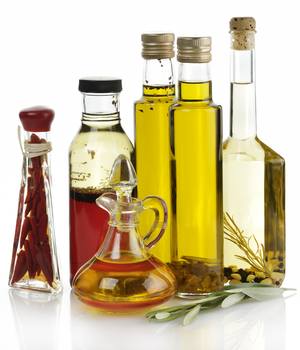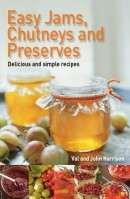Home made flavoured oils and vinegars are very easy to make and are, generally, flavoured with herbs but stronger flavoured ingredients such as chillies and garlic can also be used. In the case of vinegars, fruit is also often used. Garlic flavoured oil is a great kitchen standby as is chilli flavoured oil.
 Flavoured oils add interest to mayonnaise and salad dressings and they can also add subtle flavouring to casseroles by sealing the meat in an appropriate oil, e.g. sage oil for pork, rosemary oil for lamb.
Flavoured oils add interest to mayonnaise and salad dressings and they can also add subtle flavouring to casseroles by sealing the meat in an appropriate oil, e.g. sage oil for pork, rosemary oil for lamb.
When roasting or grilling the meat can be brushed with the oil before cooking. Alternatively, they can be used in sauces instead of other fats.
Flavoured vinegars can be used in pickles, chutneys and sauces. Those made with herbs make a good basis for salad dressings and mayonnaise. In small quantities they are useful in casseroles, curries, fish dishes and savoury sauces.
Fruit vinegars can be used as a flavouring for puddings or diluted with iced water or soda water to make a refreshing drink. They are also useful if you’ve a sore throat as they have a soothing effect.
When steeping herbs in vinegars, the bottle/jar needs to be tightly covered or the maximum flavour will be lost. Do remember that vinegar corrodes metal so use large bottles/jars with plastic screw on lids.
Flavoured Oils Safety
Of the two preserving mediums, vinegars are more effective as the acidity kills of most bacteria and they have a longer shelf life than their oil equivalents.
It is recommended to heat oils, especially with chillies and garlic as they can harbour botulism spores, to around 140ºC/285ºF before pouring into the jar/bottle. This also has the benefit of speeding up the infusion. Alternatively use dried chillies – it is the moisture in fresh chillies (and garlic) that can, possibly, allow botulism to develop
Once opened, to be on the safe side as oils also tend to go rancid relatively quickly once exposed to air, keep them in the fridge and monitor them closely for spoilage. They will need to be used up in about 2 weeks. Cold oils are the best ones to use with green herbs.
The shelf life for both oils and vinegars tends to be a shorter than most preserves and they lose some of their flavour after about 4 months.
Equipment:
- A large earthenware or glass bowl.
- Wooden spoon
- Scales
- Knives
- Bottles – clean and sterilized
- Covers – screw tops or corks
If using corks, they should be new and boiled for 10 minutes or kept submerged in boiling water for 15 minutes before use. This not only sterilizes them but makes them easier to push into the bottle. Screw tops also benefit from sterilizing in this manner.
General Tips:
- Herbs are best picked just before they come into flower, early in the morning before the sun gets too strong but not after it has rained.
- Fruit vinegars should be kept in a dark cupboards or they will loose their colour.
- Wine vinegar, although more expensive, is usually better than malt as it is less harsh and does not mask the flavouring used.
More on Oils and Vinegars
- How to Make Flavoured Oils & Vinegars
- Make Spiced & Flavoured Vinegars, Pickling Vinegars
- Storing in Oil
- Storing in Cold Oil, Botulism Risk
- Raspberry Vinegar Recipe
- Garlic Vinegar Recipe
- Chilli Vinegar Recipe
- Marjoram Vinegar Recipe
- Sage Vinegar Recipe
- Thyme Vinegar Recipe
- Tarragon Vinegar Recipe
- Garlic Oil Recipe
- Chilli Oil Recipe
- Rosemary Oil Recipe
- Quick Spiced Vinegar Recipe


